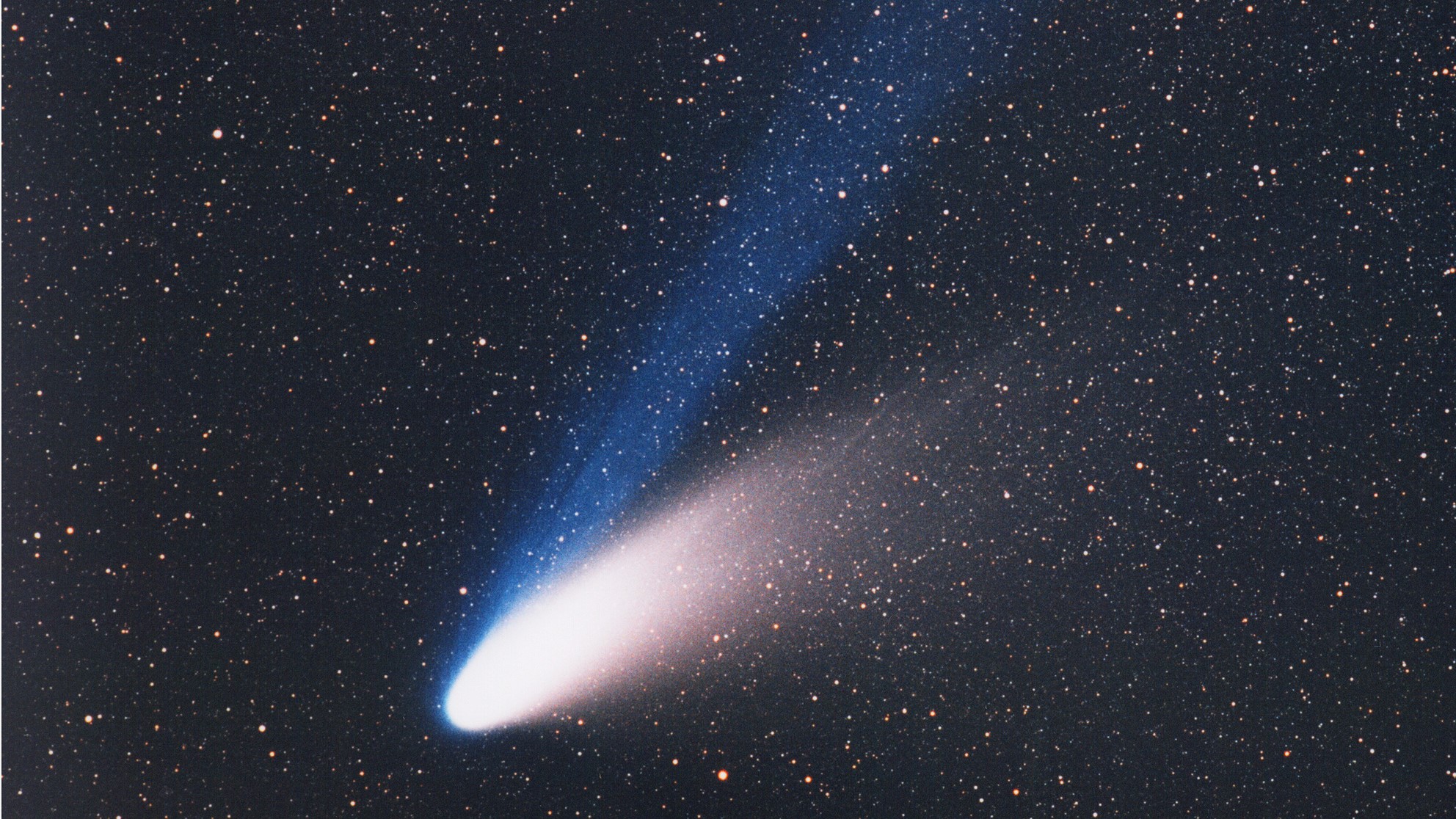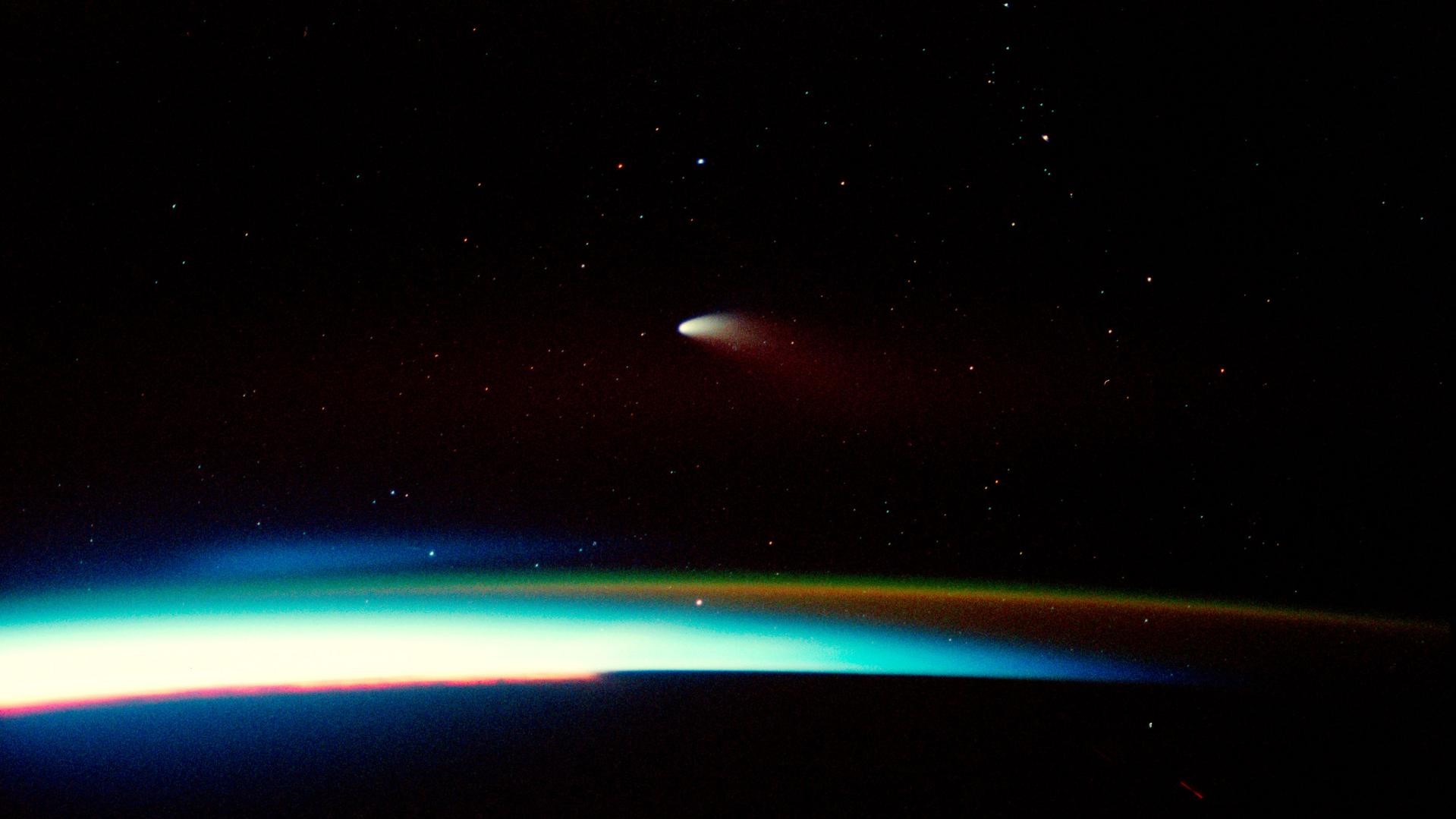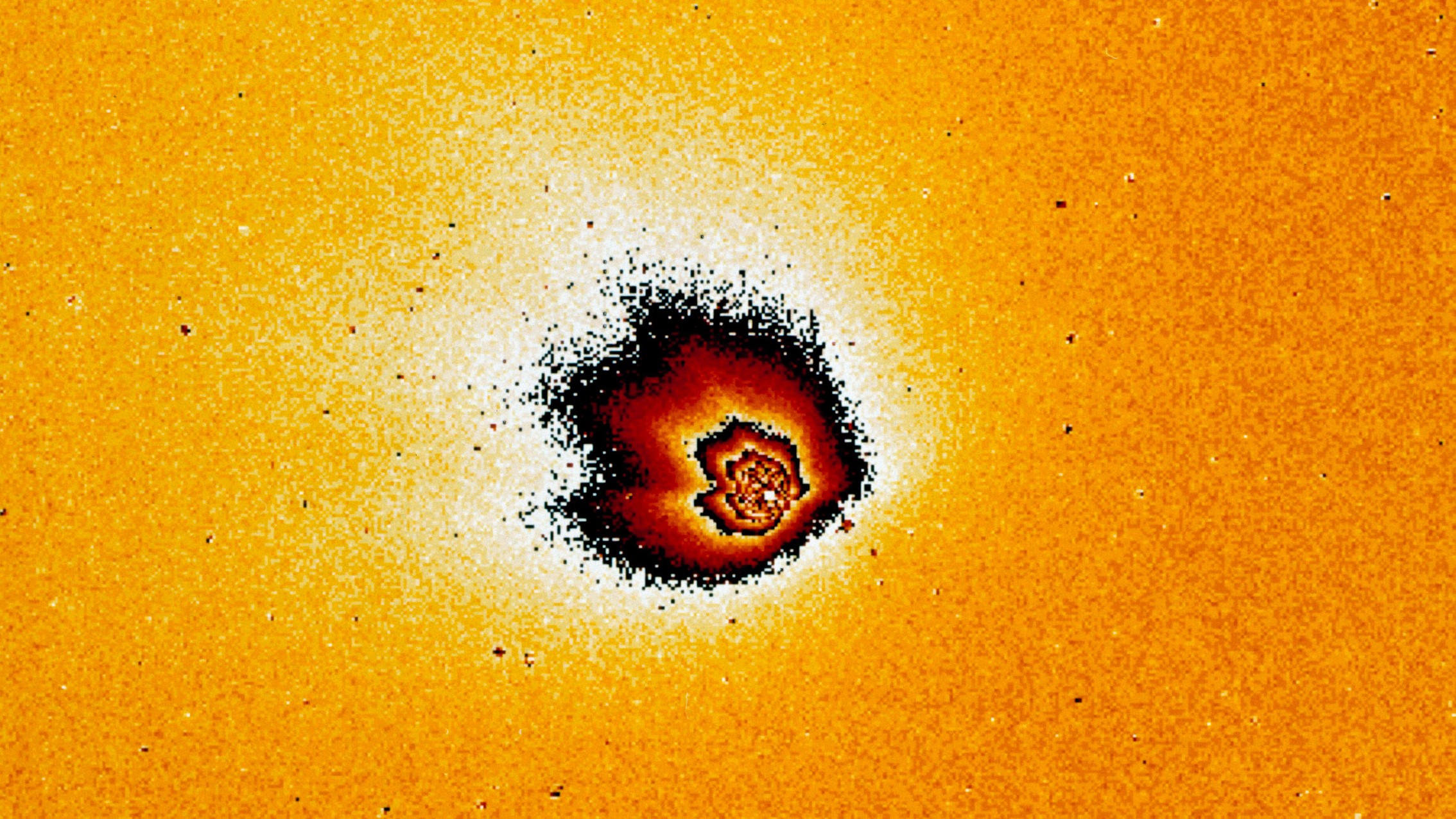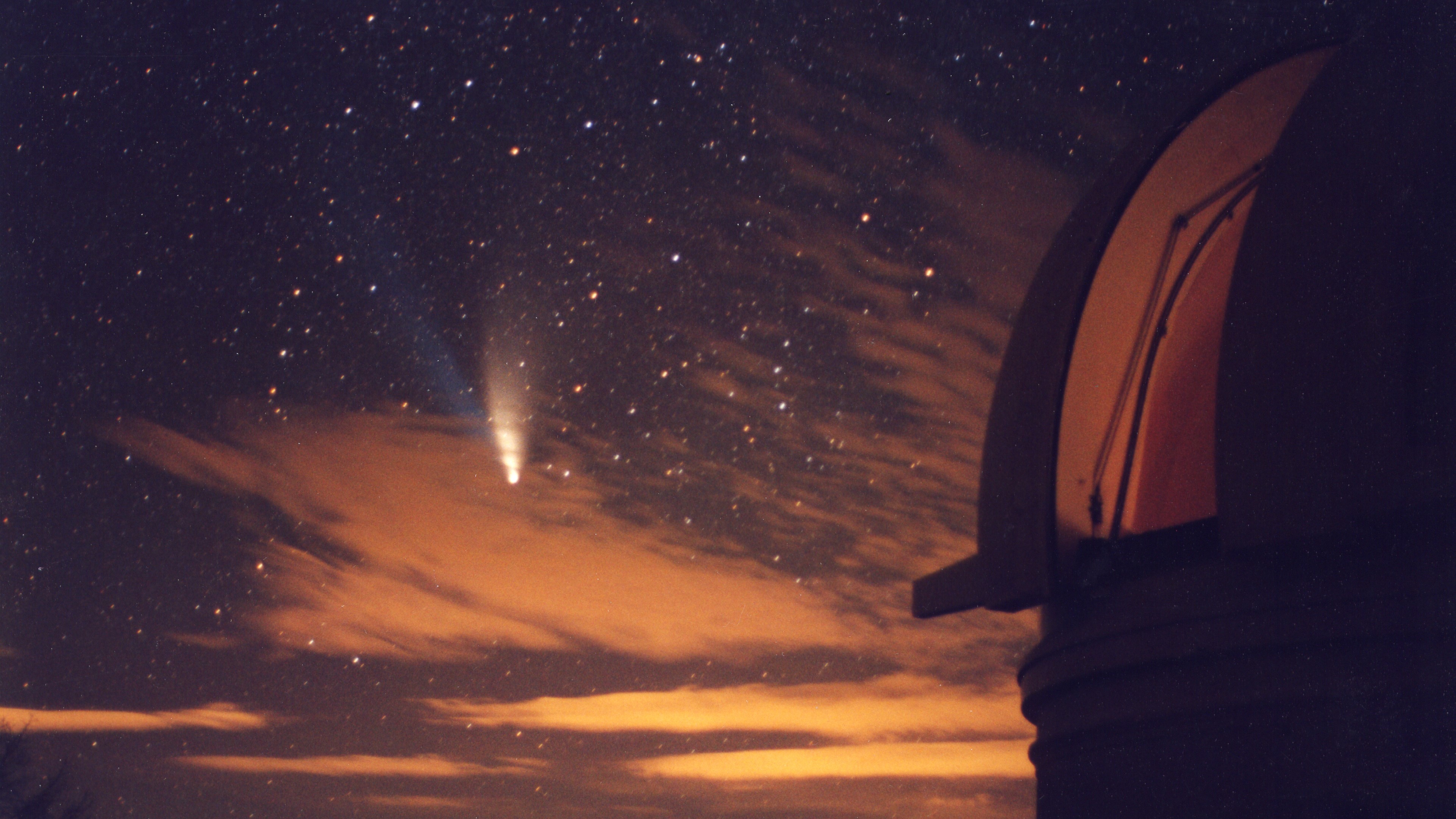Comet Hale-Bopp: Facts about the bright and tragic comet
Hale-Bopp is famed for being one of the most-watched comets in history.

Comet Hale-Bopp was an unusually bright comet that flew by Earth, reaching its closest approach to the planet in 1997. It was most spectacular in the Northern Hemisphere and visible to the naked eye for about 18 months.
Hale-Bopp was probably one of the most viewed comets in history. With an absolute magnitude of -1, the comet was one of the brightest comets to reach the inner solar system in recorded history, NASA said. Hale-Bopp appeared 1,000 times brighter than Halley's Comet did at the same distance. Its twin blue-and-white tails were clearly visible even from light-polluted areas such as Chicago.
Sadly, there was a tragic footnote to the appearance of Hale-Bopp, 39 people who were part of the "Heaven's Gate" cult in San Diego committed mass suicide as the comet came close to Earth.
Related: Comet ISON: The tricky sungrazing comet
Who discovered Hale-Bopp?

The Hale-Bopp comet was found independently by two amateur astronomers, Alan Hale in New Mexico and Thomas Bopp in Arizona. At the time of its discovery, Hale-Bopp was the farthest comet ever to be discovered by amateurs, according to NASA.
Both men trained their telescopes on nearby globular cluster M70 on July 23, 1995. Hale, who had a doctorate in astronomy but was running an educational company, had looked at the same area just days earlier and was surprised to see a new blob in the sky.
"As soon as I looked, I saw a fuzzy object nearby," he said in a 1997 Time magazine interview. "It was strange because I'd looked at M70 a couple of weeks earlier and the object hadn't been there."
Hale recalled looking at the sky a few hours later and seeing the object had moved. In his mind, he told Time, it was definitely a comet.
Almost simultaneously, Bopp saw the same object in the sky. Both men sent their observations to the International Astronomical Union's Central Bureau for Astronomical Telegrams.
Astronomers were astounded at how bright the comet, officially designated C/1995 O1, appeared even from its great distance away. While they expected the comet would be bright when it arrived close to Earth, predictions are tricky when it comes to comets — they are essentially just balls of ice and dust that erupt in ways that are hard to anticipate.
"It's been kind of nerve-racking to sit through all those months wondering if the comet would fizzle," Hale told Time.
According to NASA, Hale-Bopp's closest approach to Earth occurred on March. 22, 1997, at a distance of about 120 million miles (193 million kilometers). (By comparison, the sun is 93 million miles, or 150 million km, from Earth). Astronomers still had the bright Hyakutake comet fresh in their minds at the time as it just passed by Earth in 1996. Hale-Bopp was many times farther away than Hyakutake but still appeared much brighter.
Where did Hale-Bopp come from?

Comet Hale-Bopp is a long-period comet — defined as a comet with an orbital period of longer than 200 years according to the Swinburne University of Technology. Long-period comets usually exhibit highly elliptical orbits making them less predictable than short-period comets.
Hale-Bopp likely originated — like most long-period comets — from the Oort Cloud, a spherical collection of ice objects located approximately between 2,000 and 100,0000 Astronomical Units (AU) from the sun. One AU is the distance from Earth to the sun and is equivalent to about 93 million miles (150 million kilometers).
Objects in the Oort Cloud are so far away from the sun that gravitational perturbations from passive stars, molecular clouds or even tidal forces from the Milky Way can be enough to dislodge an object from the icy reservoir and send it on a highly elliptical orbit around the sun.
Hale-Bopp comet causes internet traffic jam
During Hale-Bopp's months-long approach to Earth, descriptions of the comet drummed up interest in newspapers and on the internet, which at the time was a young but growing public phenomenon.
"There are a multitude of websites containing information on Hale-Bopp; they are attracting so many visitors that they are causing a traffic jam on the Internet," Scientific American wrote in March 1997. "A Hale-Bopp homepage set up at NASA's Jet Propulsion Laboratory was logging more than 1.2 million visitors a day over Easter weekend and had set up two mirror sites."
It wasn't only amateurs watching the show, of course. Professional telescopes swung to watch the comet as it approached. NASA studied the comet with the Hubble Space Telescope and reported that the comet's nucleus is "huge," at 19 to 25 miles (30 to 40 km) across.
What surprised the scientists observing Hale-Bopp the most was an outburst of dust streaming from the comet's nucleus in quantities at least eight times as much as the average observations of previously observed comets.
"The surface of Hale-Bopp's nucleus must be an incredibly dynamic place, with 'vents' being turned on and off as new patches of icy material are rotated into sunlight for the first time," said Harold Weaver, a Johns Hopkins University astrophysicist who led the Hubble study.
Hale-Bopp and the Heaven's Gate cult
Heaven's Gate was an end-times cult led by Marshall Applewhite, a former music professor who advocated sexual abstinence and who had undergone castration. Members of the cult believed that their bodies were merely containers that could be abandoned in favor of a higher physical existence, History.com reported. They also thought that an alien spacecraft was following Hale-Bopp.
In late March 1997, Applewhite and 38 followers drank a lethal cocktail of Phenobarbital and vodka and lay down to die, convinced that they would leave their physical bodies, enter the alien spacecraft they believed was behind Hale-Bopp, and pass through Heaven's Gate into a higher existence. The bodies of 21 women and 18 men were found lying in bunk beds in a mansion in suburban San Diego, Calif. They wore matching clothes and new sneakers.
"According to material the group posted on its internet site, the timing of the suicides were probably related to the arrival of the Hale-Bopp comet, which members seemed to regard as a cosmic emissary beckoning them to another world," The New York Times reported in March 1997.
When will Hale-Bopp return?

Hale-Bopp represented an exciting time for astronomy. Scientists scrambled to examine the comet as much as possible during its brief cruise by Earth. The comet's last appearance in Earth's sky had been about 4,200 years before, and it won't return to the inner solar system for thousands of years.
Astronomers at the European Southern Observatory (ESO) released images of the comet in 2001, four years after Hale-Bopp was closest to Earth. By that time, the comet had soared 1.2 billion miles (2 billion km) away from Earth, about halfway between the orbits of Saturn and Uranus.
"The large 'dirty snowball' nucleus of ice and dust (probably about 50 km (31 miles) diameter) continues to be active, despite the very low temperature where it is now. This is quite unusual for a comet," ESO stated, based on observations from the La Silla Telescope in Chile.
Studying comets is particularly challenging because of how difficult it is to predict a comet's brightness. Between 2014 and 2016, Europe's Rosetta spacecraft orbited Comet 67P/Churyumov–Gerasimenko to study what happens when a comet begins its closest approach to the sun. Rosetta's studies will help scientists better make predictions about how bright comets will be.
While amateurs still discover comets from time to time, the most prolific observers tend to be automated spacecraft. For example, the Solar and Heliospheric Observatory (SOHO) satellite is designed to study solar activity, and therefore, is perfectly positioned to capture sun-grazing comets. SOHO has captured images of more than 3,000 comets since launching into space in 1995.
| Comet | Year of last visit | Year of next visit |
|---|---|---|
| Hale-Bopp | 1997 | 4385 |
| Halley's Comet | 1986 | 2061 |
| Ikeya-Seki | 1965 | 3000 |
| Lovejoy | 2011 | 2633 |
| McNaught | 2007 | 95,000 |
Additional resources
If you would like to learn more about comet Hale-Bopp check out this article by the skywatching website Comet Watch. Explore comets in more detail with this educational material from the Open University. You can find more useful Hale-Bopp material on the European Southern Observatory's Hale-Bopp webpage.
Bibliography
- Ksanfomaliti, L. V. "Some Features of Comet Hale–Bopp (According to the Observations of 1995–1998)." Solar System Research 54.2 (2020): 121-136.
- Kelley, Michael S., et al. "Frozen Oort Cloud Comet Hale-Bopp." JWST Proposal. Cycle 1 (2021): 2127.
- Cremonese, G., et al. "Neutral sodium from comet Hale-Bopp: a third type of tail." The Astrophysical Journal 490.2 (1997): L199.
Join our Space Forums to keep talking space on the latest missions, night sky and more! And if you have a news tip, correction or comment, let us know at: community@space.com.
Breaking space news, the latest updates on rocket launches, skywatching events and more!

Elizabeth Howell (she/her), Ph.D., was a staff writer in the spaceflight channel between 2022 and 2024 specializing in Canadian space news. She was contributing writer for Space.com for 10 years from 2012 to 2024. Elizabeth's reporting includes multiple exclusives with the White House, leading world coverage about a lost-and-found space tomato on the International Space Station, witnessing five human spaceflight launches on two continents, flying parabolic, working inside a spacesuit, and participating in a simulated Mars mission. Her latest book, "Why Am I Taller?" (ECW Press, 2022) is co-written with astronaut Dave Williams.
